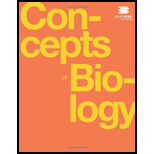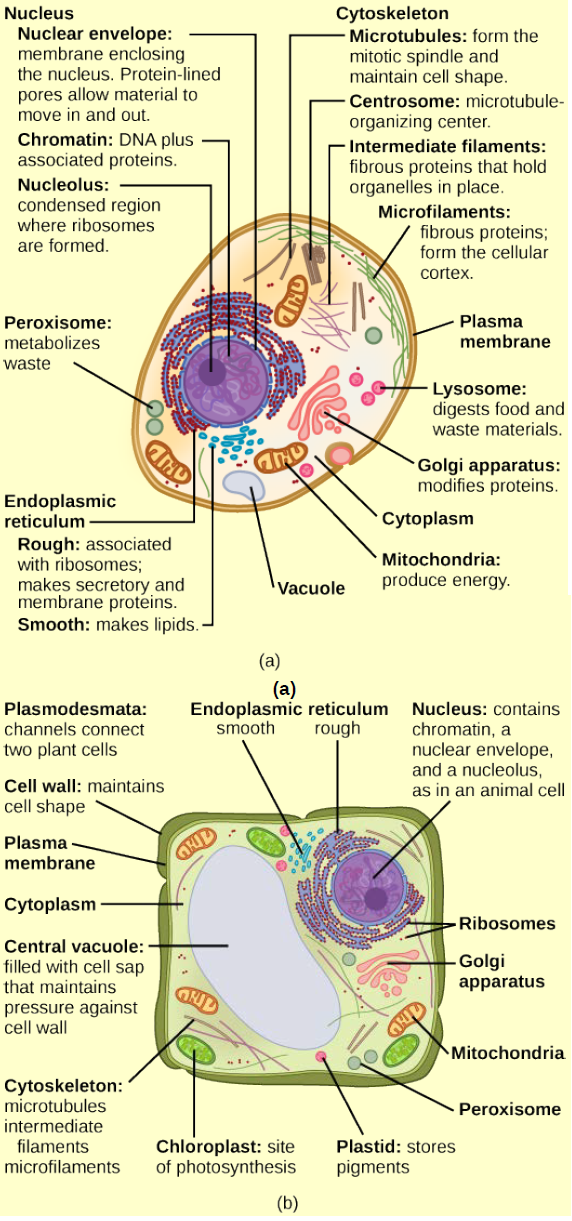
Concept explainers
Figure 3.7 What structures does a plant cell have that an animal cell does not have? What structures does an animal cell have that a plant cell does not have?

Figure 3.7 This figure shows (a) a typical animal cell and (b) a typical plant cell.
To analyze:
The similar characteristics and different features of plant cells and animal cells.
Introduction:
Both plant cells and animal cells are eukaryotic cells and have some common features. The plasma membrane, cytoplasm, nucleus, mitochondria, endoplasmic reticulum, Golgi apparatus, and ribosomes are the structures present in both plant and animal cells. Besides these structures some structures such as chloroplast, cell wall, a central vacuole are exclusively present in plant cell and similarly centrosomes, centrioles and lysosomes are present only in animal cells.
Explanation of Solution
A typical plant cell possesses a cell wall, plasmodesmata, a large central vacuole, chloroplasts, and other plastids. These structures are absent in animal cells. The cell wall is a rigid covering which protects plant cells and gives structural support to the plant cells. Plasmodesmata are the channels which connect cell to cell and involves in the transportation of materials. The water in plant cells is regulated by the central vacuole. Chloroplasts are responsible for photosynthesis in plant cells.
A typical animal cell has centrosomes which have centrioles and lysosomes. These structures are not present in the plant cells. Centrosomes are located in the microtubules and function as the organizing center. The centrioles present in them have an unknown role in the process of cell division. Lysosomes perform the function of waste disposal and contain hydrolytic enzymes for digestion.
A plant cell possesses a cell wall, plasmodesmata, a large central vacuole, chloroplasts and plastids. These structures are absent in animal cells. A animal cell has centrosomes which have centrioles and lysosomes. These structures are absent in the plant cells.
Want to see more full solutions like this?
Chapter 3 Solutions
Concepts of Biology
Additional Science Textbook Solutions
Human Physiology: An Integrated Approach (8th Edition)
Human Anatomy & Physiology (2nd Edition)
Microbiology with Diseases by Body System (5th Edition)
Concepts of Genetics (12th Edition)
Chemistry: A Molecular Approach (4th Edition)
Biological Science (6th Edition)
- Using quail and chick embryos, quail-specific antibody and fluorescent tissue-specific antibodies, design an experiment where you investigate the tissues the cranial neural crest can give rise to. What are four derivatives of the cranial neural crest that you expect to see in the resulting chimeric embryos?arrow_forwardDoes the neural crest have to undergo epithelial to mesenchymal transition prior to migration through the developing embryo? Does the neural crest differentiate into different cell types based on their axial position along the anterior and posterior axis?arrow_forwardUsing quail and chicken embryos, what kind of experiment would you conduct to test if rib forming somites have their axial identity specified before segmentation? How do we know this phenotype is due to axial identity being specified before segmentation and not due to our experimental method?arrow_forward
- 8. Aerobic respiration of a 5 mM solution of tripeptide that is composed of the following three amino acids; alanine, leucine and isoleucine. Alanine breaks down to pyruvate, leucine breaks down to Acetyl-CoA and isoleucine breaks down to succinyl-CoA. Alanine NADH FADH2 OP ATP SLP ATP Total ATP Leucine Isoleucine Totals Show your work using dimensional analysis here: 4arrow_forward9. Aerobic respiration of one lipid molecule. The lipid is composed of one glycerol molecule connected to two fatty acid tails. One fatty acid is 12 carbons long and the other fatty acid is 18 carbons long in the figure below. Use the information below to determine how much ATP will be produced from the glycerol part of the lipid. Then, in part B, determine how much ATP is produced from the 2 fatty acids of the lipid. Finally put the NADH and ATP yields together from the glycerol and fatty acids (part A and B) to determine your total number of ATP produced per lipid. Assume no other carbon source is available. fatty acids glycerol 18 carbons 12 carbons 0=arrow_forwardinfluences of environment on the phenotype.arrow_forward
- What is the difference between codominance and phenotypic plasticity?arrow_forwardExplain the differences between polygeny and pleiotropy,arrow_forwardIf using animals in medical experiments could save human lives, is it ethical to do so? In your answer, apply at least one ethical theory in support of your position.arrow_forward
- You aim to test the hypothesis that the Tbx4 and Tbx5 genes inhibit each other's expression during limb development. With access to chicken embryos and viruses capable of overexpressing Tbx4 and Tbx5, describe an experiment to investigate whether these genes suppress each other's expression in the limb buds. What results would you expect if they do repress each other? What results would you expect if they do not repress each other?arrow_forwardYou decide to delete Fgf4 and Fgf8 specifically in the limb bud. Explain why you would not knock out these genes in the entire embryo instead.arrow_forwardYou implant an FGF10-coated bead into the anterior flank of a chicken embryo, directly below the level of the wing bud. What is the phenotype of the resulting ectopic limb? Briefly describe the expected expression domains of 1) Shh, 2) Tbx4, and 3) Tbx5 in the resulting ectopic limb bud.arrow_forward
 Biology 2eBiologyISBN:9781947172517Author:Matthew Douglas, Jung Choi, Mary Ann ClarkPublisher:OpenStax
Biology 2eBiologyISBN:9781947172517Author:Matthew Douglas, Jung Choi, Mary Ann ClarkPublisher:OpenStax Biology Today and Tomorrow without Physiology (Mi...BiologyISBN:9781305117396Author:Cecie Starr, Christine Evers, Lisa StarrPublisher:Cengage Learning
Biology Today and Tomorrow without Physiology (Mi...BiologyISBN:9781305117396Author:Cecie Starr, Christine Evers, Lisa StarrPublisher:Cengage Learning Concepts of BiologyBiologyISBN:9781938168116Author:Samantha Fowler, Rebecca Roush, James WisePublisher:OpenStax College
Concepts of BiologyBiologyISBN:9781938168116Author:Samantha Fowler, Rebecca Roush, James WisePublisher:OpenStax College





